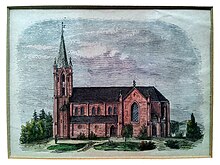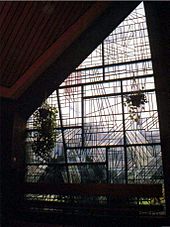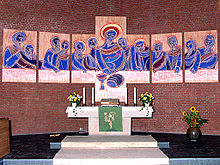Gustav-Adolf-Church (Meppen)
The Gustav-Adolf-Kirche belongs to the oldest Protestant parish of the same name in Meppen . It was built from 1856 to 1858 as the "Evangelical Church of Meppen" based on a design by the architect Conrad Wilhelm Hase (Hanover) and was given its current name in 1953. In 1966/67 it was rebuilt in its current form.
Church planting
In connection with the Reichsdeputationshauptschluss on February 25, 1803 and as a result of the secularization , the Duke of Arenberg received the office of Meppen as a replacement for the loss of areas on the left bank of the Rhine to France next to Vest Recklinghausen . In the course of the reorganization of Europe after the Congress of Vienna from 1814 to 1815, the Meppen office was assigned to the Kingdom of Hanover , with the Duke of Arenberg retaining civil rights. As a result, Protestant royal officials and soldiers came to Meppen. According to the responsible Major General Vincke, in 1817 there was neither a Protestant church nor a school within a four-hour radius, so that the children could not be taught and there was no pastoral support in the event of illness or death .
On March 27, 1842, the congregation received Carl Prior, until then “candidate and assistant to Pastor Voss from Schledehausen ” as pastor. After the school authorities canceled their promise that the auditorium of the Catholic grammar school could be used for Protestant services, these initially took place in private homes.
The church building 1856-1858
The building of the church was planned with the beginning of Prior's work. The community was dependent on the support of third parties as it had no real estate and thus no sources of income. That is why people turned to the consistory in Osnabrück and the king in Hanover again and again . These authorities covered part of the cost. They also enabled the community to collect a house in the Landvogtei- or Landdrosteien Osnabrück and Ostfriesland zu Aurich . This door-to-door collection extended over several years. In 1854 the church council decided to build the church.
The planning in the brick Gothic style was carried out by the Hanoverian architect Conrad Wilhelm Hase . The construction of the church and the building materials used should remain visible to the viewer. “Plaster is a lie” was a word he coined. The foundation stone was laid on May 9, 1856. At that time the community counted around 300 souls in the city and in the country parish of Meppen, and in the entire duchy there were 1000 souls.
In 1857, Pastor Prior from Meppen was recalled. Despite the vacant pastor's position, the construction of the church continued. The church was consecrated on June 10, 1858. On this day the later consistorial councilor and superintendent Wilhelm Grashoff took over the pastor's office. He was active in Meppen until his death in 1903.
Construction work in the 1950s and 1960s
The church suffered the worst damage in World War II in January 1944 and February 1945. When the Hitler Youth offered resistance to invading Canadian troops on April 7, 1945, they shot at the towers of the Evangelical and Catholic Churches, suspecting spying posts. Both churches were badly damaged. The Catholic Church lost the entire spire , in the Protestant church the spire was shot to pieces, the church roof and the windows destroyed. The effects of the weather subsequently increased the damage. The 1950s and 1960s were characterized by repair work and various church renovations and new buildings.
After the church was put back into use after the war, further damage occurred, which required major construction work. This was particularly necessary because the number of community members had more than doubled due to the refugees from the east.
Repair in 1953
The architect Werner Zobel from Nordhorn was hired for the first renovation in 1953. He probably wanted to keep the cross shape in the floor plan of the church, but change the external and internal appearance. In the end, Zobel based himself on the existing building and designed a church that could accommodate up to 500 people. The altar Bible and the pulpit, damaged by a splinter during the attacks, have been preserved from the old church.
Naming
The church until then simply called the “Evangelical Church of Meppen” was named “Gustav Adolf Church”, dedicated to the Gustav Adolf work , which supports congregations in the diaspora .
Bells
The church received its new bells for the 100th anniversary . The tower was rebuilt for this purpose. The bells were driven through the city in a ceremonial procession on May 27, 1958. The large death bell (625 kg), tuned to A, bears the inscription of Paul from the letter to the Romans : "Be patient in tribulation"; the middle bell, tuned to C (355 kg) with the inscription “Be happy in hope”, rings for baptisms and weddings; and the small prayer and evening bell tuned to D with the inscription “Stop at the prayer” rings in the morning at 8 o'clock, at noon at 12 o'clock and in the evening at 6 o'clock and frames and accompanies the seven petitions of the Our Father's prayer in the service.
New building in 1966/67
The construction work continued after a short time. Ever new war damage and further growth in the community had made a thorough renovation necessary. In May 1966 the regional church of Hanover approved the funds. The architects Brüx and Schumacher were commissioned to plan the construction work. The execution was in the hands of the Nordhorn architect Bortfeld. In September 1966 the foundation stone was laid for the new building; On December 17, 1967, State Superintendent Kurt Degener inaugurated the new church together with Superintendent Wilhelm Stühl and Pastor Werner Knorr.
The tapered roof is reminiscent of a tent that served as a sanctuary for the wandering people of God Israel in the desert. The church wants to offer a space of calm. Altar, baptismal font and pulpit are made of Bentheim sandstone . A simple wooden cross stood behind the altar.
Window by Hans Ohlms
Since the church was also available to the local Reformed congregation in the early days, it was deliberately kept simple. Only the glass windows created by Hans Ohlms (1908–1988), Nordhorn, set an artistic accent. "The windows should make you restless like in the Book of Job", is how the pastor Christian Langer quotes and interprets the artist. “Man, born of women, lives a short time and is full of restlessness.” The artist provokes the restlessness by designing the windows very differently. In addition to strict lines that take up the structural element of the brickwork, there is a strongly moving pattern in the baptismal window, but also calm waves in the side windows. In contrast, the windows in the wall of the church tower copy and mirror the concentric pattern in 18 individual units. On the lighter side of the church to the south and west, cool blue and gray tones are preferred, while warm tones are preferred on the darker north side. At the very top of the otherwise closed altar wall, three small colored windows symbolize the Trinity of God.
Construction work in the 1990s
In 1994 the altarpiece was installed, in 1997 the church ceiling was renovated and the organ was rebuilt.
Altarpiece
The five-part altarpiece by the Nordhorn artist Jo Klose invites the worshipers to join the circle of the disciples of Jesus around the Lord's table during the Last Supper and to close this circle. That this invitation is not only the community present applies, but to all Christians targeted the world to make the words of Jesus clearly be read on the altarpiece in various ancient and modern languages, namely, Greek (language of the New Testament , connection to Greek Orthodox Church ), Latin (church language until the 16th century; connection to the Roman Catholic Church ), Cyrillic (many parishioners come from Russia ; connection to the Russian Orthodox Church ), English (world language; connection to the Anglican Church ), German and in Swahili (language of the partner community Chemchem in Tanzania ).
Above the heads of the disciples are their names in Greek; from left to right: Matthew, Thomas, Bartholomäus, Philippus, Andreas, Petrus, Johannes, Jakobus, son of Zebedäus, Jakobus, Thaddäus, Simon and Judas.
Above Jesus' head you can read in Greek: Jesus Christ, the Son of God, the Redeemer . Bread and wine , but also the symbol of the fish, are of fundamental importance for Christians; the colors stand for strength of faith (blue), love (red), and eternity (gold). The Bible verse from 2 Mos 12,14 LUT , quoted under chalice and bread in Hebrew scriptures, reminds us that Christians understand the Lord's Supper in the tradition of the Jewish Passover .
organ
The rebuilding of the organ took a long time. The documents repeatedly referred to serious deficiencies in the existing instrument. In the 1960s and 70s, the old organ was repaired with the support of the regional church. In the mid-1990s, after long pros and cons, the church council decided to rebuild the organ.
It was built in 1997 by the Marcussen & Søn organ building workshop . The instrument has 27 registers , divided into two manuals and a pedal . The action is mechanical, the wind chests designed as sliding chests.
|
|
|
|||||||||||||||||||||||||||||||||||||||||||||||||||||||||||||||
- Coupling : I / II, I / P, II / P
Jesus blessing

The "Blessing Christ" by Johann Heinrich Ramberg (1763-1840) came to Meppen in the second half of the 19th century by unknown routes and hung in the church until the new church was built in 1966/67. It was felt to be out of date and was stored in the attic of the superintendent until it was given on permanent loan to the Meppener Heimatverein's town museum in 1990 . After the celebrations for the 150th anniversary of the parish fair in 2008, the picture returned to the church. It hangs somewhat hidden above the sacristy , opposite the pulpit .
literature
- Ems- und Haseblätter, public organ for the higher court district of Meppen from July 9, 1854
- Arno Piechorowski (Ed.): Hans Ohlms. Works for the sacred space. Langenau-Ahlbeck 1981.
- Michael Schmidt: Meppen in the Kingdom of Hanover (1815–1866). In: City of Meppen (ed.): The history of the city of Meppen. Meppen 2006.
- Peter Veddeler: The city of Meppen in the French era. In: City of Meppen (ed.): The history of the city of Meppen. Meppen 2006.
Sources in the parish archive
- Letter dated January 30, 1817 from Major General Vincke to His Royal Highness the Duke of Cambridge
- Letter from Carl Prior to the Royal Evangelical Consistory in Osnabrück dated March 27, 1841 (application for the pastor's position in Meppen)
- Stock book for the evangelical, Protestant community for the Duchy of Arenberg Meppen, 1842 (started) (entries by Prior and Grashoff)
- Visit report from Superintendent Wilhelm Funke, 1948
Web links
Individual evidence
- ^ History of the City of Meppen, p. 276
- ^ History of the City of Meppen, p. 291
- ^ Letter from Major General Vincke dated January 30, 1817
- ^ Letter from Carl Prior dated March 27, 1841
- ^ Letter from Prior, Weiss, Dincklage and Kusian dated July 4, 1842
- ↑ Stock book p. 10
- ↑ Ems- und Haseblätter Public organ for the higher court district of Meppen from July 9, 1954
- ↑ Conrad Wilhelm Hase # quotations
- ↑ Stock book p. 14
- ↑ Stock book p. 149ff
- ^ Visit report from Superintendent Wilhelm Funke 1948
- ↑ Zobel submitted various drafts, available in the municipal archive.
- ↑ He wanted to divide the sanctuary so that the congregation would gather around the altar in four groups of seats. The pulpit was closely connected to the altar. Obviously these “modern” ideas could not be realized.
- ^ September 26, 1966 in the Meppener Tagespost
- ↑ The picture is a montage that was modeled on descriptions by church members. The altarpiece was removed by retouching and the cross, which is now on the left side wall of the church, was added.
- ↑ Hans Ohlms, p. 46f
- ↑ Hans Ohlms p. 43
- ↑ ibid.
- ↑ The Marcussen Organ. (No longer available online.) Archived from the original on October 14, 2013 ; Retrieved October 13, 2013 .
Coordinates: 52 ° 41 ′ 45.4 " N , 7 ° 17 ′ 44.2" E






